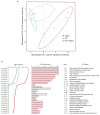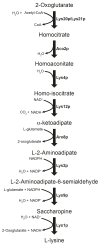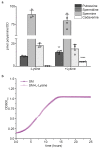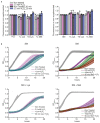Lysine harvesting is an antioxidant strategy and triggers underground polyamine metabolism
- PMID: 31367038
- PMCID: PMC6774798
- DOI: 10.1038/s41586-019-1442-6
Lysine harvesting is an antioxidant strategy and triggers underground polyamine metabolism
Abstract
Both single and multicellular organisms depend on anti-stress mechanisms that enable them to deal with sudden changes in the environment, including exposure to heat and oxidants. Central to the stress response are dynamic changes in metabolism, such as the transition from the glycolysis to the pentose phosphate pathway-a conserved first-line response to oxidative insults1,2. Here we report a second metabolic adaptation that protects microbial cells in stress situations. The role of the yeast polyamine transporter Tpo1p3-5 in maintaining oxidant resistance is unknown6. However, a proteomic time-course experiment suggests a link to lysine metabolism. We reveal a connection between polyamine and lysine metabolism during stress situations, in the form of a promiscuous enzymatic reaction in which the first enzyme of the polyamine pathway, Spe1p, decarboxylates lysine and forms an alternative polyamine, cadaverine. The reaction proceeds in the presence of extracellular lysine, which is taken up by cells to reach concentrations up to one hundred times higher than those required for growth. Such extensive harvest is not observed for the other amino acids, is dependent on the polyamine pathway and triggers a reprogramming of redox metabolism. As a result, NADPH-which would otherwise be required for lysine biosynthesis-is channelled into glutathione metabolism, leading to a large increase in glutathione concentrations, lower levels of reactive oxygen species and increased oxidant tolerance. Our results show that nutrient uptake occurs not only to enable cell growth, but when the nutrient availability is favourable it also enables cells to reconfigure their metabolism to preventatively mount stress protection.
Figures












Comment in
-
Yeast cells handle stress by reprogramming their metabolism.Nature. 2019 Aug;572(7768):184-185. doi: 10.1038/d41586-019-02288-y. Nature. 2019. PMID: 31384051 No abstract available.
Similar articles
-
Polyamine metabolism in Saccharomyces cerevisiae exposed to ethanol.Microbiol Res. 1998 Aug;153(2):179-84. doi: 10.1016/S0944-5013(98)80038-4. Microbiol Res. 1998. PMID: 9760751
-
Tpo1-mediated spermine and spermidine export controls cell cycle delay and times antioxidant protein expression during the oxidative stress response.EMBO Rep. 2013 Dec;14(12):1113-9. doi: 10.1038/embor.2013.165. Epub 2013 Oct 18. EMBO Rep. 2013. PMID: 24136413 Free PMC article.
-
Elevation of cellular Mg2+ levels by the Mg2+ transporter, Alr1, supports growth of polyamine-deficient Saccharomyces cerevisiae cells.J Biol Chem. 2019 Nov 8;294(45):17131-17142. doi: 10.1074/jbc.RA119.009705. Epub 2019 Sep 22. J Biol Chem. 2019. PMID: 31548311 Free PMC article.
-
Characteristics of cellular polyamine transport in prokaryotes and eukaryotes.Plant Physiol Biochem. 2010 Jul;48(7):506-12. doi: 10.1016/j.plaphy.2010.01.017. Epub 2010 Jan 28. Plant Physiol Biochem. 2010. PMID: 20159658 Review.
-
Regulation of polyamine biosynthesis by antizyme and some recent developments relating the induction of polyamine biosynthesis to cell growth. Review.Biosci Rep. 1985 Mar;5(3):189-204. doi: 10.1007/BF01119588. Biosci Rep. 1985. PMID: 3893559 Review.
Cited by
-
Integrating Multi-Type Component Determination and Anti-Oxidant/-Inflammatory Assay to Evaluate the Impact of Pre-Molting Washing on the Quality and Bioactivity of Cicadae Periostracum.Molecules. 2022 Nov 8;27(22):7683. doi: 10.3390/molecules27227683. Molecules. 2022. PMID: 36431784 Free PMC article.
-
Recent Advances in Marine-Based Nutraceuticals and Their Health Benefits.Mar Drugs. 2020 Dec 9;18(12):627. doi: 10.3390/md18120627. Mar Drugs. 2020. PMID: 33317025 Free PMC article. Review.
-
Transportome-wide engineering of Saccharomyces cerevisiae.Metab Eng. 2021 Mar;64:52-63. doi: 10.1016/j.ymben.2021.01.007. Epub 2021 Jan 16. Metab Eng. 2021. PMID: 33465478 Free PMC article.
-
Wide-ranging organic nitrogen diets of freshwater picocyanobacteria.ISME J. 2025 Jan 2;19(1):wrae236. doi: 10.1093/ismejo/wrae236. ISME J. 2025. PMID: 39987554 Free PMC article.
-
The power of microbes: the key role of gut microbiota in the initiation and progression of colorectal cancer.Front Oncol. 2025 Apr 14;15:1563886. doi: 10.3389/fonc.2025.1563886. eCollection 2025. Front Oncol. 2025. PMID: 40297806 Free PMC article. Review.
References
-
- Kuehne A, et al. Acute Activation of Oxidative Pentose Phosphate Pathway as First-Line Response to Oxidative Stress in Human Skin Cells. Mol Cell. 2015;59:359–371. - PubMed
-
- Mima S, et al. Identification of the TPO1 gene in yeast, and its human orthologue TETRAN, which cause resistance to NSAIDs. FEBS Lett. 2007;581:1457–1463. - PubMed
-
- Albertsen M, Bellahn I, Kramer R, Waffenschmidt S. Localization and function of the yeast multidrug transporter Tpo1p. J Biol Chem. 2003;278:12820–12825. - PubMed
-
- Uemura T, Tachihara K, Tomitori H, Kashiwagi K, Igarashi K. Characteristics of the polyamine transporter TPO1 and regulation of its activity and cellular localization by phosphorylation. J Biol Chem. 2005;280:9646–9652. - PubMed
Publication types
MeSH terms
Substances
Grants and funding
LinkOut - more resources
Full Text Sources
Medical
Molecular Biology Databases
Research Materials

